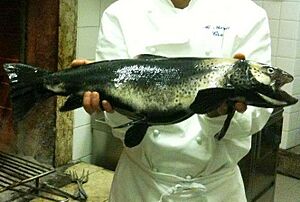Carpione facts for kids
Quick facts for kids Carpione |
|
|---|---|
 |
|
| Conservation status | |
| Scientific classification | |
| Genus: |
Salmo
|
| Species: |
carpio
|
The carpione (Salmo carpio), also known as the Lake Garda carpione, is a special type of fish. It belongs to the salmonid family, like salmon and trout. This fish is found only in Lake Garda in Italy. It's an "endemic" species, meaning it naturally lives nowhere else. Sadly, the carpione population in Lake Garda is shrinking fast. Experts now consider it critically endangered, which means it's at a very high risk of disappearing forever. The main reasons for this decline are too much fishing, pollution in the lake, and possibly competition from other fish species that were brought into the lake.
Contents
About the Carpione Fish
What Does It Look Like?
Adult carpione fish are usually silvery. They have very few black spots on their bodies. You will hardly see any spots on their heads. During their mating season, some male carpione can change color. They might get dark, patchy patterns on their bodies. These fish can grow up to 50 cm (20 in) long.
Where Does It Live?
Carpione fish mostly live in the deep parts of Lake Garda. They prefer depths of about 100 to 200 m (328 to 656 ft). In the summer, they eat tiny water creatures called zooplankton. They also eat small crustaceans that live on the lake bottom.
How Do They Live and Reproduce?
Both male and female carpione become ready to have babies at two or three years old. They usually mate every one or two years. Spawning, which is when they lay eggs, happens in winter or summer. They lay their eggs deep underwater, from 50 to 300 metres (160 to 980 ft) deep. They often choose spots near underwater springs. The oldest these fish usually get is about five years.
Why Is the Carpione Endangered?
The number of carpione fish in Lake Garda is dropping very quickly. In just ten years leading up to 2006, their numbers went down by 80%. This is a huge concern for the fish.
Main Threats
- Too much fishing: People might be catching too many carpione. This leaves fewer fish to reproduce.
- Lake pollution: The water in Lake Garda might be getting dirty. Pollution can harm the fish and their food.
- Habitat damage: The places where carpione live and lay eggs might be getting ruined.
- New fish species: Other fish, like Coregonus species, have been introduced to the lake. These new fish might be competing with the carpione for food and space.
Because of these threats, the IUCN (International Union for Conservation of Nature) has listed the carpione as "Critically Endangered". This means it's very close to disappearing forever.
Helping the Carpione
To save the carpione, a special project has started. It's called a captive breeding project. This means scientists are trying to breed the fish in a controlled environment.
Good News from the Project
The first results from this project are promising. They have successfully produced many eggs, young fish (fry), and slightly older fish (juveniles). Not many of these young fish are dying. The hope is to keep some adult carpione for breeding. Later, these fish can be released back into Lake Garda. This effort aims to help the carpione population grow again in its natural home.


